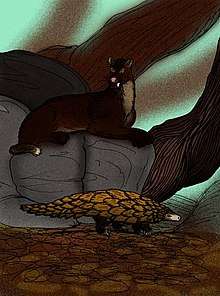Necromanis
Necromanis is an extinct genus of pholidotan from the Oligocene and Miocene of France. It was originally placed within Manidae, but was eventually removed from it as more fossil pholidotids from outside that family were found and studied more extensively (i.e., with the discovery and study of Eomanis and Patriomanis).[1] Currently, Necromanis is placed as incertae sedis within the pholidotid superfamily Manoidea, together with the families Manidae and Patriomanidae.[2]
| Necromanis | |
|---|---|
 | |
| N. franconica and Sansanosmilus | |
| Scientific classification | |
| Kingdom: | |
| Phylum: | |
| Class: | |
| Order: | |
| Superfamily: | Manoidea |
| Family: | |
| Genus: | †Necromanis Filhol, 1893 |
| Type species | |
| Lutra franconica Quenstedt, 1886 | |
| Species | |
| |
| Synonyms | |
| |
N. quercyi was originally placed within Teutomanis by Ameghino in 1905, but was later subsumed into Necromanis. A new fossil humerus attributed to N. franconica from Quercy, France lead researchers to reaffirm Teutomanis quercyi's status as distinct from Necromanis.[3]
References
- Gaudin, Timothy J., Robert J. Emry, and Brandon Pogue. "A new genus and species of pangolin (Mammalia, Pholidota) from the late Eocene of Inner Mongolia, China." Journal of Vertebrate Paleontology 26.1 (2006): 146-159.
- Gaudin, Timothy J., Robert J. Emry, and John R. Wible. "The phylogeny of living and extinct pangolins (Mammalia, Pholidota) and associated taxa: a morphology based analysis." Journal of mammalian evolution 16.4 (2009): 235-305.
- CROCHET, J. Y., HAUTIER, L., & LEHMANN, T. (2015). A pangolin (Manidae, Pholidota, Mammalia) from the French Quercy phosphorites (Pech du Fraysse, Saint-Projet, Tarn-et-Garonne, late Oligocene, MP 28). Palaeovertebrata, 39(2), e4.
This article is issued from Wikipedia. The text is licensed under Creative Commons - Attribution - Sharealike. Additional terms may apply for the media files.